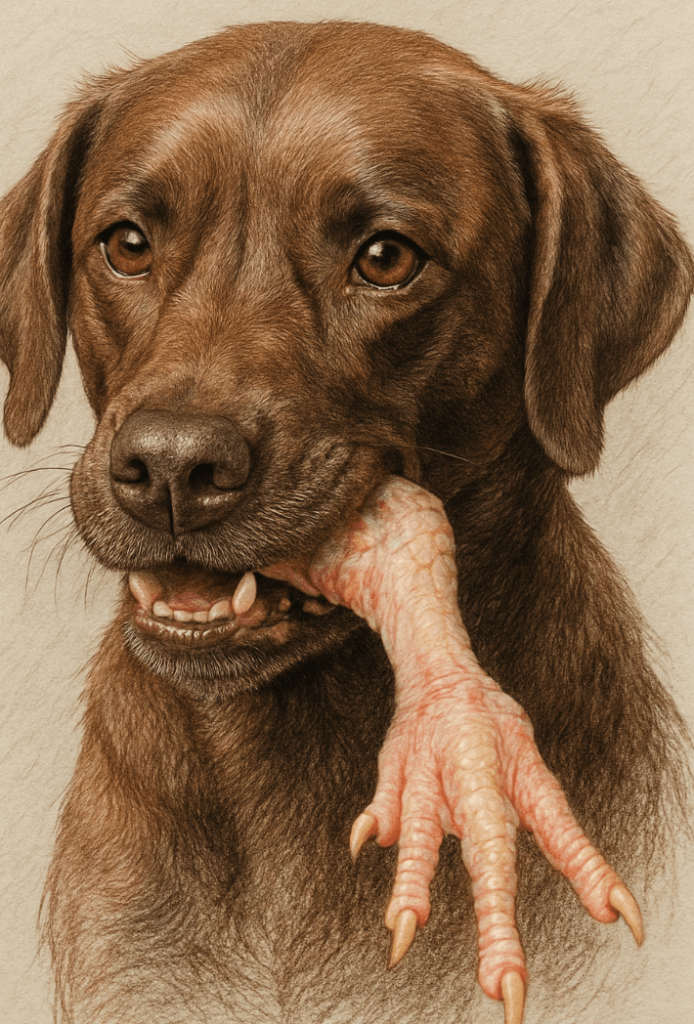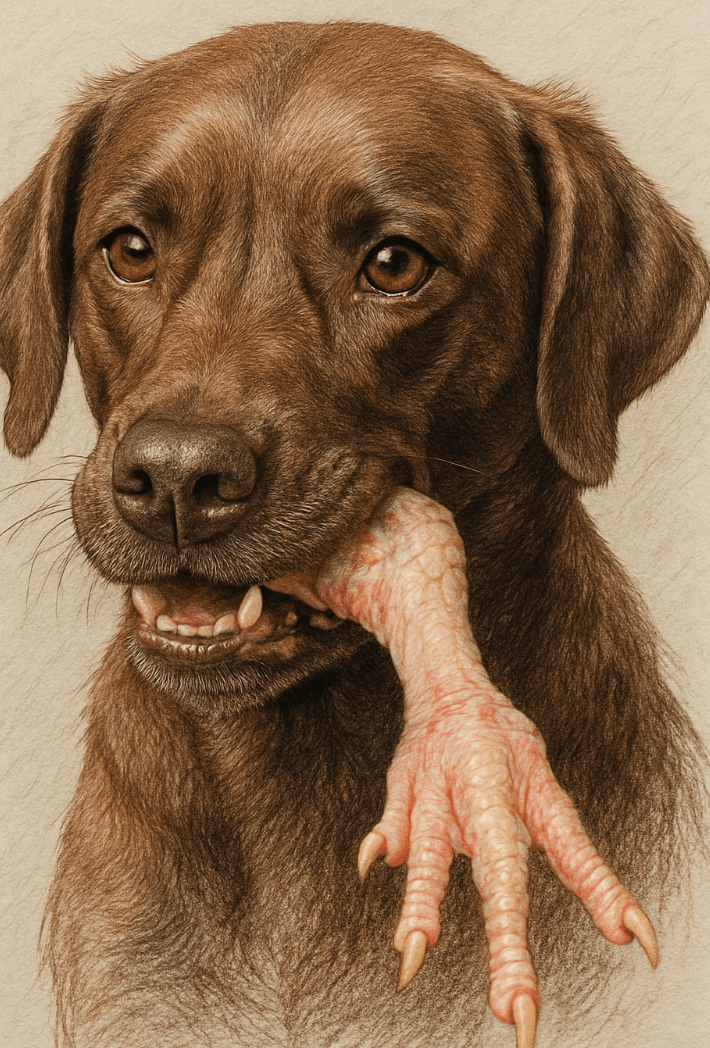Can Dogs Eat Raw Chicken Feet?
Raw chicken feet have gained popularity among pet owners as a natural and nutritious treat for dogs. Packed with collagen, glucosamine, and other beneficial nutrients, they are often touted for supporting joint health and dental hygiene. However, the idea of feeding raw chicken feet to your dog may raise questions about safety, preparation, and potential risks. Can dogs safely consume raw chicken feet, and what precautions should you take? In this blog post, we’ll explore the benefits, risks, and best practices for incorporating raw chicken feet into your dog’s diet. Whether you’re a seasoned raw feeder or just curious, this guide will help you make informed decisions about your furry friend’s nutrition.
Benefits of Feeding Raw Chicken Feet to Dogs
Raw chicken feet offer several health benefits that make them an appealing addition to your dog’s diet. Here’s why many pet owners choose to include them in their feeding routine.
Rich in Collagen:
Collagen supports skin, coat, and joint health, helping maintain your dog’s overall vitality.Natural Source of Glucosamine:
Glucosamine aids in joint lubrication and can be particularly beneficial for senior dogs or those prone to arthritis.Dental Hygiene Benefits:
Chewing on raw chicken feet helps clean teeth and reduce plaque buildup, promoting better oral health.High in Protein:
Chicken feet are an excellent source of lean protein, essential for muscle development and energy.Low in Fat:
Unlike many commercial treats, raw chicken feet are low in fat, making them a healthier snack option.
These benefits highlight why raw chicken feet are considered a nutritious treat for dogs when fed responsibly.
Potential Risks of Feeding Raw Chicken Feet
While raw chicken feet can be beneficial, they also come with certain risks that every pet owner should consider. Understanding these hazards is crucial for ensuring your dog’s safety.
Risk of Bacterial Contamination:
Raw chicken may carry harmful bacteria like Salmonella or E. coli, which can pose health risks to both dogs and humans.Choking Hazards:
Small bones or improperly prepared feet can become lodged in your dog’s throat, leading to choking or injury.Digestive Upset:
Sudden introduction of raw foods may cause vomiting, diarrhea, or other digestive issues in some dogs.Allergic Reactions:
Though rare, some dogs may develop allergies or sensitivities to raw chicken feet.Nutritional Imbalance:
Overfeeding raw chicken feet can lead to an unbalanced diet if they replace more nutrient-dense meals.
By being aware of these risks, you can take steps to minimize potential problems and ensure your dog’s well-being.
Check this guide 👉Can Dogs Eat Tater Tots? Best 7 Expert Tips!
Check this guide 👉Can Dogs Eat Sardines in Olive Oil? Best 7 Expert Tips!
Check this guide 👉Can Dogs Eat Cactus? Best 7 Expert Tips!

Benefits of Raw Chicken Feet | Risks of Feeding Raw Chicken Feet |
|---|---|
Rich in collagen for joint and skin health | Risk of bacterial contamination (e.g., Salmonella) |
Natural source of glucosamine for joints | Choking hazards from small bones |
Promotes dental hygiene through chewing | Potential digestive upset |
High in lean protein for energy | Allergic reactions in sensitive dogs |
Low in fat, making it a healthy snack | Risk of nutritional imbalance |
How to Safely Prepare Raw Chicken Feet for Your Dog
Feeding raw chicken feet requires proper preparation to ensure your dog’s safety. Follow these guidelines to minimize risks and maximize benefits.
Source High-Quality Feet:
Purchase raw chicken feet from reputable suppliers or trusted butchers to reduce the risk of contamination.Clean Thoroughly:
Rinse the chicken feet under cold water to remove dirt, debris, and potential contaminants before serving.Remove Nails:
Trim or file down the sharp nails to prevent injury to your dog’s mouth or digestive tract.Freeze Before Serving:
Freezing raw chicken feet for at least 72 hours can kill parasites and reduce bacterial load.Introduce Gradually:
Start by offering small portions to monitor your dog’s reaction and avoid overwhelming their digestive system.
By following these steps, you can provide your dog with a safe and nutritious treat.
Signs Your Dog May Not Tolerate Raw Chicken Feet
Even with careful preparation, some dogs may not tolerate raw chicken feet well. Watch for these signs to determine if this treat is suitable for your pet.
Vomiting or Diarrhea:
These symptoms may indicate digestive upset or an intolerance to raw chicken feet.Excessive Drooling:
Drooling could signal irritation or discomfort caused by the texture or size of the treat.Lethargy or Discomfort:
A sudden lack of energy or signs of pain might suggest an allergic reaction or internal issue.Difficulty Swallowing:
If your dog struggles to swallow or seems to choke, discontinue feeding immediately.Changes in Behavior:
Unusual behaviors like pawing at the mouth or refusing food may indicate a problem.
Recognizing these signs early allows you to act quickly and protect your dog’s health.
Common Mistakes to Avoid When Feeding Raw Chicken Feet
Feeding raw chicken feet requires attention to detail to avoid mistakes that could harm your dog. Here are some pitfalls to watch out for.
Skipping the Freezing Process:
Failing to freeze raw chicken feet increases the risk of bacterial contamination and parasites.Overfeeding as Treats:
Too many chicken feet can disrupt your dog’s balanced diet and lead to nutritional deficiencies.Ignoring Allergies or Sensitivities:
Some dogs may react poorly to raw chicken; always observe their response closely.Not Removing Nails Properly:
Sharp nails can injure your dog’s mouth or digestive tract if left intact.Neglecting Veterinary Advice:
Skipping a professional opinion can result in unknowingly harming your dog with inappropriate feeding practices.
Avoiding these mistakes ensures a safer and healthier experience for your dog.
Alternatives to Raw Chicken Feet for Joint Health
If you’re hesitant about feeding raw chicken feet, there are alternative options that support joint health without the associated risks.
Glucosamine Supplements:
Commercial supplements specifically formulated for dogs provide joint support without raw food risks.Bone Broth:
Strained, unsalted bone broth is rich in nutrients and easy to digest, making it a safe alternative.Dehydrated Chicken Feet:
Dehydrated versions eliminate bacterial concerns while retaining nutritional benefits.Fish-Based Treats:
Fish like salmon or sardines are excellent sources of omega-3 fatty acids, supporting joint and skin health.Vegetable Chews:
Carrots, sweet potatoes, or pumpkin chews offer dental benefits and fiber for digestion.
These alternatives allow you to cater to your dog’s needs while minimizing potential dangers.
Understanding Your Dog’s Nutritional Needs
Before introducing raw chicken feet or any new food, it’s important to understand your dog’s unique nutritional requirements.
Age and Activity Level:
Puppies, active adults, and senior dogs have different dietary needs; adjust portion sizes accordingly.Breed-Specific Considerations:
Large breeds may benefit more from joint-supporting foods, while small breeds require smaller, easily chewable treats.Existing Health Conditions:
Dogs with allergies, obesity, or gastrointestinal issues need tailored diets to avoid exacerbating their conditions.Balanced Diet Importance:
Treats like raw chicken feet should complement, not replace, a complete and balanced diet.Individual Preferences:
Every dog is different—some may love raw chicken feet, while others may prefer alternative snacks.
By considering these factors, you can create a feeding plan that supports your dog’s overall health and happiness.
Frequently Asked Questions About Feeding Raw Chicken Feet to Dogs
Are raw chicken feet safe for all dogs?
While most dogs tolerate them well, puppies, seniors, or immunocompromised dogs may be at higher risk for complications.
Can I feed cooked chicken feet instead?
Yes, cooking removes some risks but reduces nutritional value; avoid seasoning or adding oils.
How often should I feed my dog raw chicken feet?
Limit servings to 1-2 times per week as a treat, ensuring they don’t replace balanced meals.
What if my dog swallows a bone fragment?
Monitor for signs of distress and contact your vet if you suspect any internal injury.
Should I consult my vet before feeding raw chicken feet?
Yes, especially if your dog has underlying health conditions or dietary restrictions.
Making the Right Choice for Your Dog’s Diet
Feeding raw chicken feet to your dog can be a nutritious and enjoyable addition to their diet, provided you approach it with care and caution. By understanding the benefits, risks, and proper preparation methods, you can ensure your furry friend stays healthy and happy. Always prioritize your dog’s individual needs and consult your veterinarian if you’re unsure about introducing new foods. With the right balance, raw chicken feet can become a valuable part of your dog’s nutritional routine, supporting their overall well-being and happiness.
Cat Fever Treatment: Best 7 Expert Tips! Discover expert advice on identifying, managing, and treating fever in cats to ensure their quick recovery and well-being.
Understanding Meloxicam for Cats: Best 7 Expert Tips! Learn how to safely administer meloxicam, manage side effects, and ensure your cat's comfort with expert advice on feline pain relief.
Amoxicillin for Cat UTI: Best 7 Expert Tips! Discover safe usage, dosage guidelines, and expert advice on treating feline urinary tract infections effectively with amoxicillin.
Understanding Cat Cancer Treatment: Best 7 Expert Tips! Discover expert advice on managing feline cancer, from early detection to treatment options, ensuring your cat’s health and comfort.





